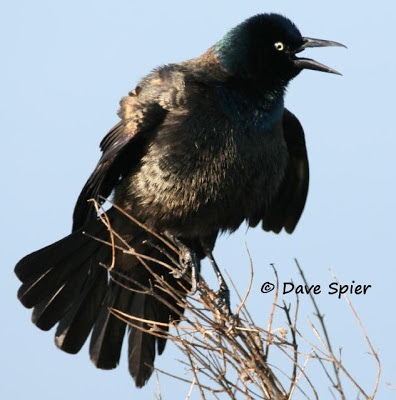The grackles are back - no surprise here since many types of birds are returning from the South. These are the "half-hardies" that tolerate some cold weather or a late snowstorm. You may have noticed Snow Geese, a variety of puddle ducks, Turkey Vultures, Killdeer, and lots of blackbirds. Mixed in with flocks of redwings, and often out-numbering them, are the larger grackles with their long tails that can fold into keel-shaped V’s when they fly, especially on the males. The long tails can make the wings look short.
In bright light, inland Common Grackles (Quiscalus quiscula) exhibit glossy blue heads and iridescent-bronze backs. Depending on the type and direction of the light, the head color can vary from green to purple. Males are larger and shinier than females. Young birds in summer and fall are dull and dark brown with dark eyes. Adults have pale yellow eyes. Near the Atlantic coast, there is a race of Common Grackles called "purple" because the bronze color is replaced by deep blue or multi-coloring on the back. Southeastern male grackles may exhibit purple around the neck.
 |
| Bronzed race of the Common Grackle -- here a male is "singing" to proclaim a territory |
Common Grackles occupy a wide variety of habitats, both upland and wetland, and are particularly well suited to living near humans. They are omnivores and eat just about anything they can swallow. Both redwings and grackles, along with cowbirds, will pick up dropped seeds under feeders in late winter and early spring when there is a shortage of other foods. Like gulls, they will follow plows to catch fleeing insects and mice. Later in the spring, their taste for corn sprouts will make them pests. In the summer they eat ripening corn. They steal worms from robins and they kill and eat smaller birds, especially nestlings. In the fall, they use their hard beaks to open and eat acorns.
Common Grackles spread out during nesting season, but regroup by the thousands for autumn migration. Winter roosts shared with other blackbirds in the South can number in the millions.
For more information visit All About Birds. Although classified as a song bird (passerine), the grackle's voice is more akin to shrieks and squeaks. Click on "Typical Voice" for a sample. For an interactive range map, go to eBird's "Explore Data" tab.
Common Grackles are found east of the Rockies. A larger grackle species, the Boat-tailed, is found along the Atlantic, Florida and Gulf coasts. Female Boat-tail's are brownish on the body and head. A similar species, the Great-tailed, is found from Southern California to Oklahoma and south into Mexico. Female Great-tail's are grayer than female Boat-tail's.
Good birding!
Good birding!
-------------------------
Corrections, comments and questions are always welcome at northeastnaturalist@yahoo.com or connect through my Facebook page and photo page. There's also a community-type page for The Northeast Naturalist.
